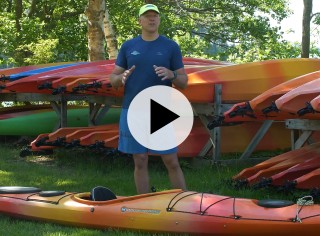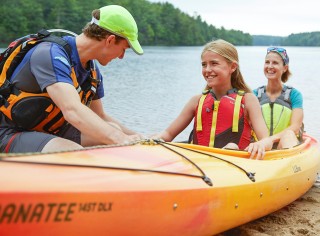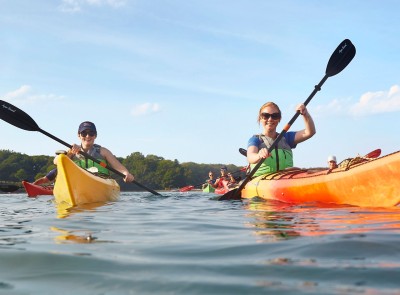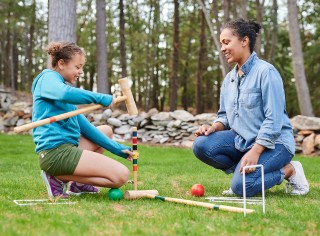How to Paddle a Kayak
Get in the know before you get on the water
Originally, kayaks were used by early Inuit tribes to hunt and fish, but lucky for us over the years these sleek boats have also become a popular way to explore the coastline with friends, take in the sheer magnificence of nature and have some serious fun time on the water. Before you grab a paddle and head for the shoreline, check out these tips so you can get the most out of every stroke.
How to Size Your Paddle
Before you learn how to hold and use your paddle, it’s important to make sure it’s the right size. The sizing of a paddle all depends on the width of the kayak and not the height of the person. If you’re paddling a sea kayak that is 20 to 23 inches wide, you want a paddle that’s 210 cm to 220 cm. If you’re paddling in more of a recreational kayak, you want a paddle that’s 230 cm or more – so you have more length to get over the sides of the boat.
How to Hold Your Paddle
Most modern paddles come in two pieces that fit together. When you grab your paddle, you’re going to find the center seam where they connect. Place that part of the paddle carefully on top of your head, make a right angle with both arms and then bring the paddle down in front of you. Make sure the power face of the blade (curved part) is facing you. You want to make sure your knuckles are lined up with the top edge of the blade on both sides. Lightly grip with the first finger of each hand, while the rest of your fingers keep a nice light grip on the paddle shaft.
One of the ways to be really efficient at paddling is to use your torso and core muscles. This is called torso rotation. To practice, put your paddle down in front of you (hip level) with your elbows down and relaxed. Raise the paddle to waist level with forearms extended, elbows still relaxed by your side. This is what’s called a paddler’s box. If you keep your arms in this position when paddling and rotate your body by winding up and unwinding, you're using torso rotation. This method is healthier, far more efficient, and you’ll get a lot more miles without paddling so hard.
Forward and Reverse Sweep
Since kayaks don’t always go straight due to wind, water, current or operator related issues, the forward and reverse strokes help you turn the kayak.
For the forward sweep, it’s a low shaft angle. This means the paddle shaft is almost parallel to the surface of the water. Reach out with the power face of the paddle (curved part) facing you towards your toe and unwind your core, carving a big smiley face in the water from your feet all the way to the back edge of the boat.
A reverse sweep uses a climbing blade angle. This simply means that the blade of the paddle starts flat at the tail of the board and unwinds to a vertical position by the time you recover it at your feet. First, torso rotate towards the stern of the kayak (back) and put the back face flat on the water. Using the climbing blade technique, unwind your core, carving a big smiley face just under the surface all the way to your toes.
FORWARD STROKE
You’ll use this stroke 90% of the time just getting from point A to point B. Start with a 45-degree shaft angle, so the paddle is steeper off the surface. Dip the paddle into the water by your toes at that 45-degree angle and unwind your core just to your hip using torso rotation. This should give you a super short stroke to take you forward
REVERSE STROKE
This stroke is great when you need to back out of areas that you may not be able to turn around in. For a reverse stroke, one of the first and most important things you need to do is torso rotate towards the back of the kayak to look over your shoulders so you can see where you’re going. Put the back face flat in the water at your hip, unwind with torso rotation to your knee with a climbing blade and shaft angle for a super short stroke. Remember always check what’s behind you.
HOW TO STOP
To stop you’re basically going to take three short reverse strokes. Right off your hip, back face flat, little climbing angle on one side, little climbing angle on the other side, and little climbing angle on the original side. This will help ease you to a stop and keep you in the direction you were headed..
Related Stories




